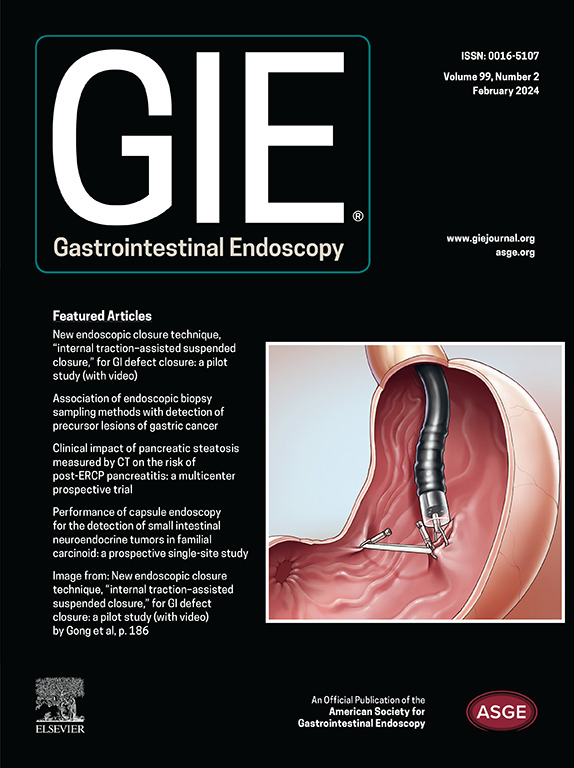Glucagon-like peptide-1 receptor agonists and capsule endoscopy in patients with diabetes: a matched cohort study
IF 6.7
1区 医学
Q1 GASTROENTEROLOGY & HEPATOLOGY
引用次数: 0
Abstract
Background and Aims
Video capsule endoscopy (VCE) is valuable for assessing conditions like GI bleeding, anemia, and inflammatory bowel disease. Glucagon-like peptide-1 receptor agonists (GLP-1RAs) are prescribed for diabetes and weight loss, with their pharmacologic effects including delayed gastric emptying. This study investigates the impact of GLP-1RA use on VCE outcomes in patients with diabetes.
Methods
This retrospective cohort study involves patients with diabetes undergoing VCE while on GLP-1RAs matched in a 1:1 ratio with control subjects, who are not on GLP-1RAs, based on demographics and diabetes-related factors. The primary outcome was gastric transit time in VCE studies, whereas secondary outcomes were incomplete small-bowel evaluation and small-bowel transit time.
Results
In the GLP-1RA cohort with 68 patients, 5 (7%) experienced failure to pass the video capsule through the stomach; all control subjects passed the video capsule successfully (P = .06). GLP-1RA patients had a longer gastric transit time (99.3 ± 134.2 minutes) compared with control subjects (25.3 ± 31.6 minutes, P < .001). Multivariate analysis revealed GLP-1RA use was associated with an increased gastric transit time by 74.5 minutes (95% confidence interval, 33.8-115.2; P < .001) compared with control subjects, after adjusting for relevant factors. Sixteen GLP-1RA patients (23.5%) experienced incomplete passage of the video capsule through the small intestine, a significantly higher rate compared with 3 patients in the control group (4.4%, P < .01).
Conclusions
GLP-1RA use is associated with a prolonged gastric transit time and a higher rate of incomplete small-bowel evaluation during VCE. Future studies may be crucial for evaluating strategies to mitigate these effects.
糖尿病患者的胰高血糖素样肽-1 受体激动剂和胶囊内镜检查:匹配队列研究
背景和目的:视频胶囊内镜(VCE)对于评估胃肠道出血、贫血和炎症性肠病等疾病具有重要价值。胰高血糖素样肽-1 受体激动剂(GLP-1 RA)是治疗糖尿病和减肥的处方药,其药理作用包括延迟胃排空。本研究调查了使用 GLP-1 RA 对糖尿病患者 VCE 结果的影响:这项回顾性队列研究涉及服用 GLP-1 RA 期间接受 VCE 的糖尿病患者,并根据人口统计学和糖尿病相关因素与未服用 GLP-RA 的对照组进行 1:1 比对。VCE研究的主要结果是胃转运时间,次要结果是不完全小肠评估和小肠转运时间:在 68 名 GLP-1 RA 患者中,有 5 人(7%)经历了 VCE 无法通过胃部的情况,而所有对照组患者都成功通过了胃部(P=0.06)。与对照组(25.3±31.6 分钟,P)相比,GLP-1 RA 患者的胃通过时间更长(99.3±134.2 分钟):使用 GLP-1 RA 与 VCE 期间胃转运时间延长和小肠评估不完整率升高有关。未来的研究可能对评估减轻这些影响的策略至关重要。
本文章由计算机程序翻译,如有差异,请以英文原文为准。
求助全文
约1分钟内获得全文
求助全文
来源期刊

Gastrointestinal endoscopy
医学-胃肠肝病学
CiteScore
10.30
自引率
7.80%
发文量
1441
审稿时长
38 days
期刊介绍:
Gastrointestinal Endoscopy is a journal publishing original, peer-reviewed articles on endoscopic procedures for studying, diagnosing, and treating digestive diseases. It covers outcomes research, prospective studies, and controlled trials of new endoscopic instruments and treatment methods. The online features include full-text articles, video and audio clips, and MEDLINE links. The journal serves as an international forum for the latest developments in the specialty, offering challenging reports from authorities worldwide. It also publishes abstracts of significant articles from other clinical publications, accompanied by expert commentaries.
 求助内容:
求助内容: 应助结果提醒方式:
应助结果提醒方式:


